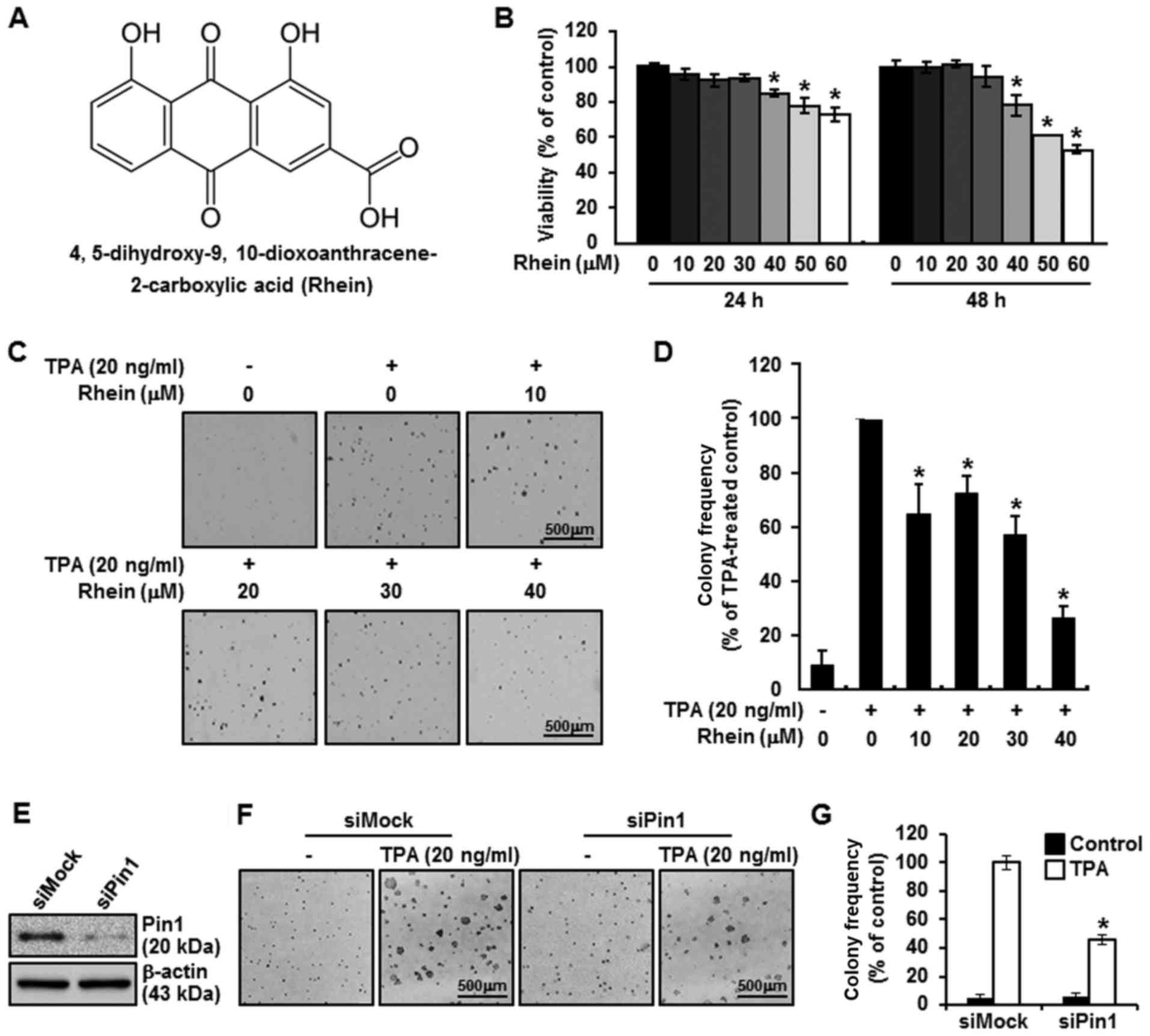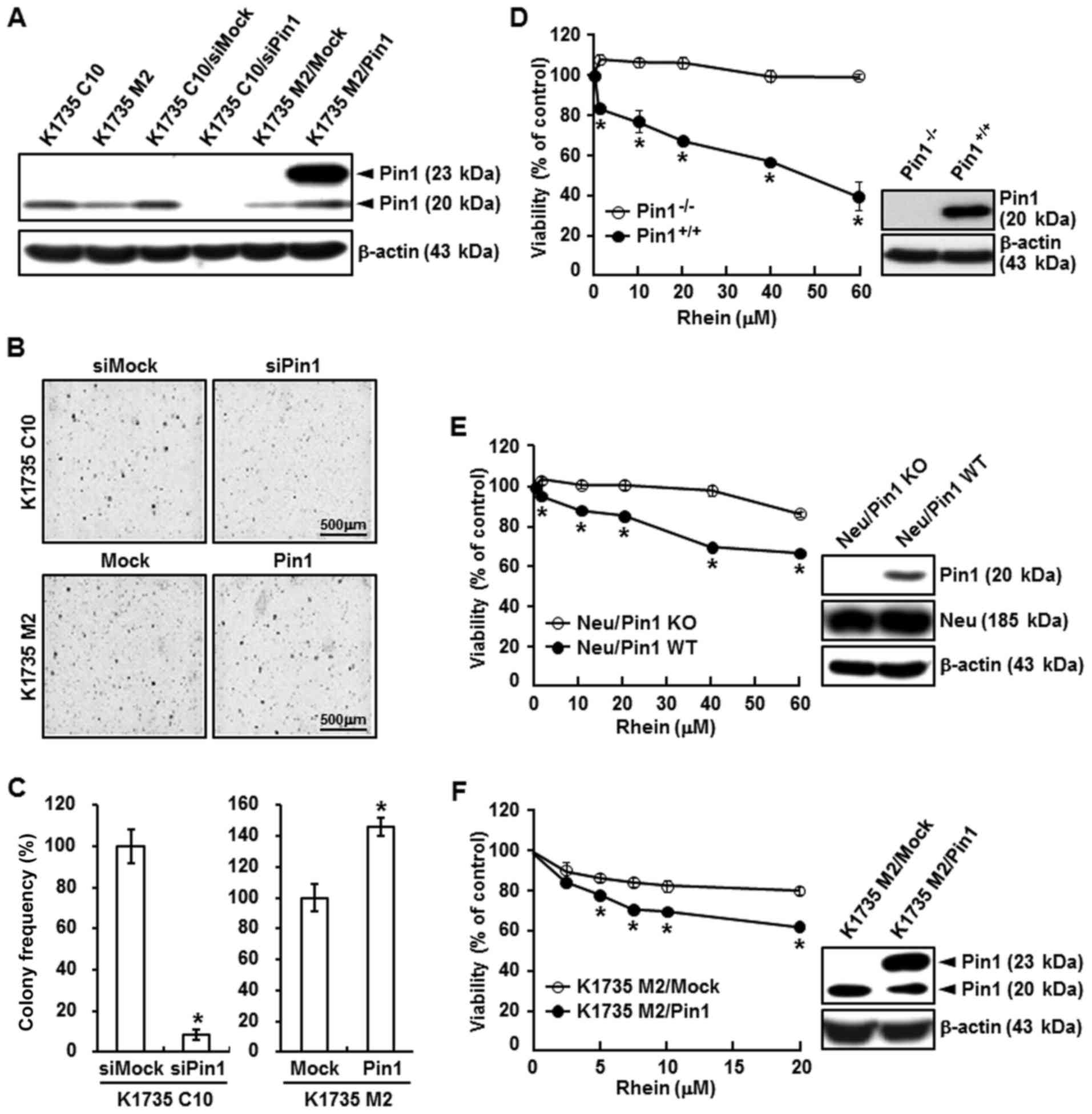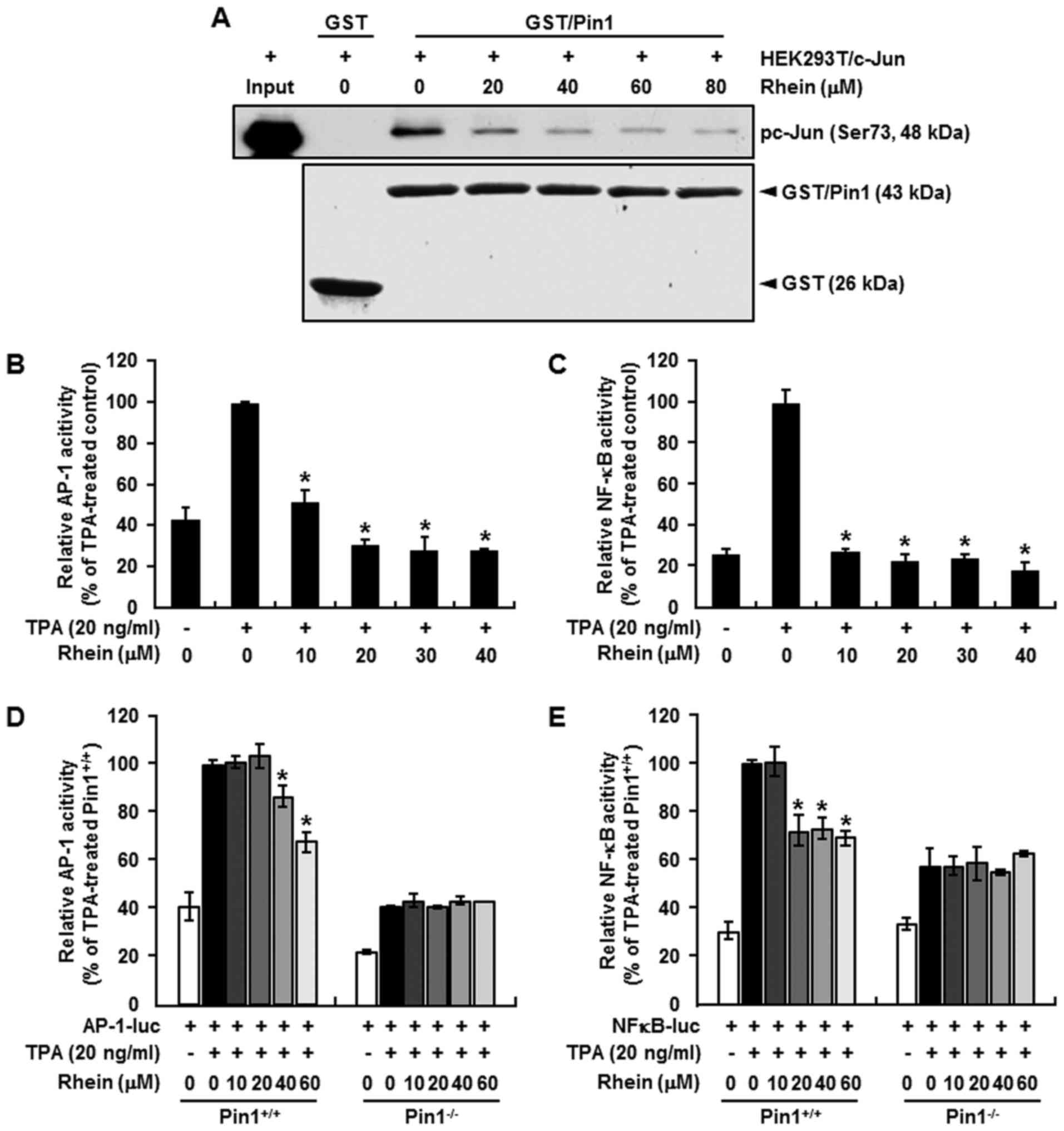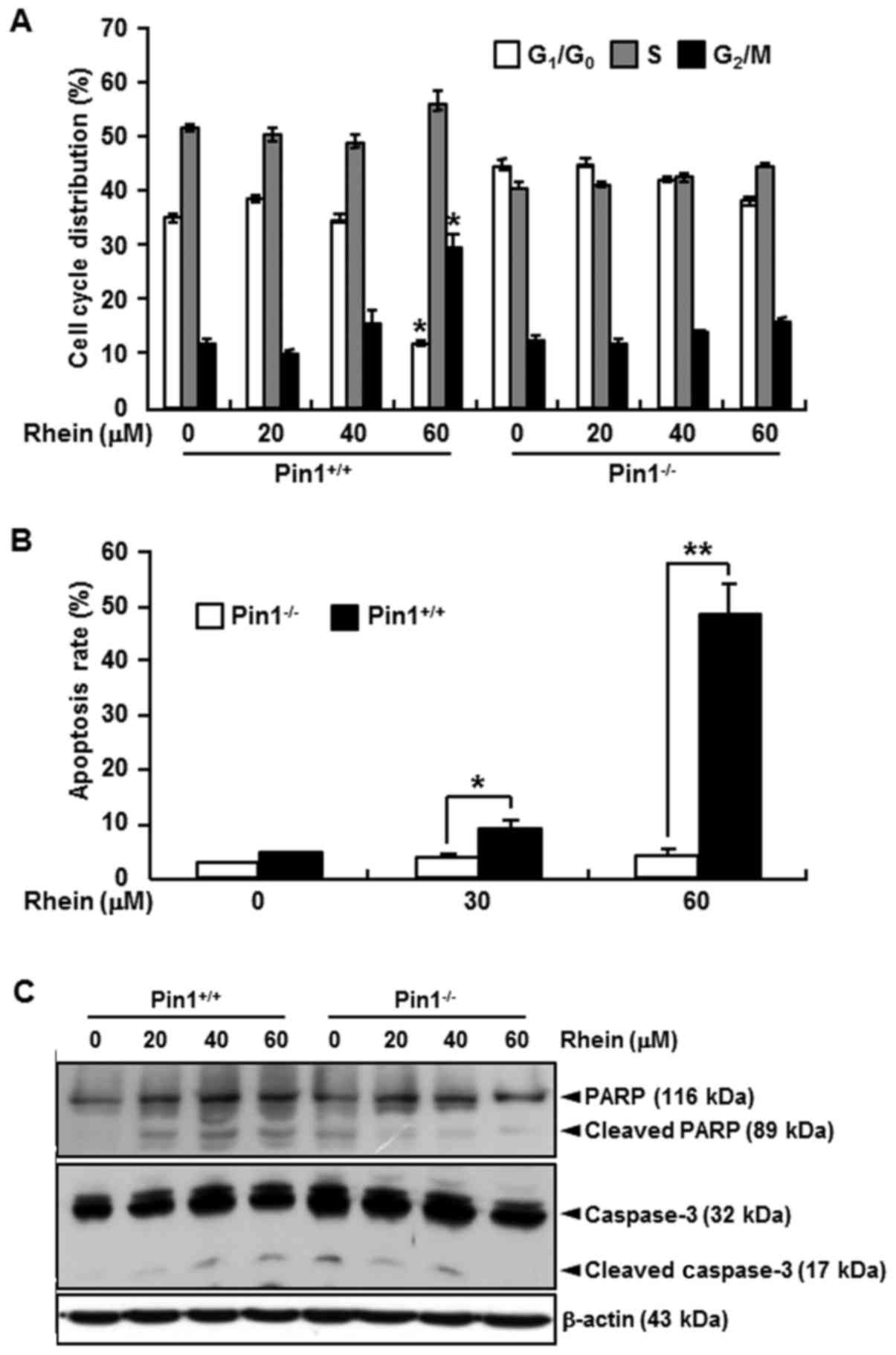|
1
|
Li Y, Xu Y, Lei B, Wang W, Ge X and Li J:
Rhein induces apoptosis of human gastric cancer SGC-7901 cells via
an intrinsic mitochondrial pathway. Braz J Med Biol Res.
45:1052–1059. 2012. View Article : Google Scholar : PubMed/NCBI
|
|
2
|
Tsang SW and Bian ZX: Anti-fibrotic and
anti-tumorigenic effects of rhein, a natural anthraquinone
derivative, in mammalian stellate and carcinoma cells. Phytother
Res. 29:407–414. 2015. View
Article : Google Scholar : PubMed/NCBI
|
|
3
|
Tsang SW, Zhang H, Lin C, Xiao H, Wong M,
Shang H, Yang ZJ, Lu A, Yung KK and Bian Z: Rhein, a natural
anthraquinone derivative, attenuates the activation of pancreatic
stellate cells and ameliorates pancreatic fibrosis in mice with
experimental chronic pancreatitis. PLoS One. 8:e822012013.
View Article : Google Scholar : PubMed/NCBI
|
|
4
|
Lai WW, Yang JS, Lai KC, Kuo CL, Hsu CK,
Wang CK, Chang CY, Lin JJ, Tang NY, Chen PY, et al: Rhein induced
apoptosis through the endoplasmic reticulum stress, caspase- and
mitochondria-dependent pathways in SCC-4 human tongue squamous
cancer cells. In Vivo. 23:309–316. 2009.PubMed/NCBI
|
|
5
|
Chen YY, Chiang SY, Lin JG, Yang JS, Ma
YS, Liao CL, Lai TY, Tang NY and Chung JG: Emodin, aloe-emodin and
rhein induced DNA damage and inhibited DNA repair gene expression
in SCC-4 human tongue cancer cells. Anticancer Res. 30:945–951.
2010.PubMed/NCBI
|
|
6
|
Chen YY, Chiang SY, Lin JG, Ma YS, Liao
CL, Weng SW, Lai TY and Chung JG: Emodin, aloe-emodin and rhein
inhibit migration and invasion in human tongue cancer SCC-4 cells
through the inhibition of gene expression of matrix
metalloproteinase-9. Int J Oncol. 36:1113–1120. 2010.PubMed/NCBI
|
|
7
|
Aviello G, Rowland I, Gill CI, Acquaviva
AM, Capasso F, McCann M, Capasso R, Izzo AA and Borrelli F:
Anti-proliferative effect of rhein, an anthraquinone isolated from
Cassia species, on Caco-2 human adenocarcinoma cells. J Cell Mol
Med. 14:2006–2014. 2010. View Article : Google Scholar : PubMed/NCBI
|
|
8
|
Lin YJ and Zhen YS: Rhein lysinate
suppresses the growth of breast cancer cells and potentiates the
inhibitory effect of Taxol in athymic mice. Anticancer Drugs.
20:65–72. 2009. View Article : Google Scholar : PubMed/NCBI
|
|
9
|
Shi P, Huang Z and Chen G: Rhein induces
apoptosis and cell cycle arrest in human hepatocellular carcinoma
BEL-7402 cells. Am J Chin Med. 36:805–813. 2008. View Article : Google Scholar : PubMed/NCBI
|
|
10
|
Ip SW, Weng YS, Lin SY, Mei-Dueyang Tang
NY, Su CC and Chung JG: The role of Ca+2 on rhein-induced apoptosis
in human cervical cancer Ca Ski cells. Anticancer Res. 27:379–389.
2007.PubMed/NCBI
|
|
11
|
Shrimali D, Shanmugam MK, Kumar AP, Zhang
J, Tan BK, Ahn KS and Sethi G: Targeted abrogation of diverse
signal transduction cascades by emodin for the treatment of
inflammatory disorders and cancer. Cancer Lett. 341:139–149. 2013.
View Article : Google Scholar : PubMed/NCBI
|
|
12
|
Domagala F, Martin G, Bogdanowicz P,
Ficheux H and Pujol JP: Inhibition of interleukin-1beta-induced
activation of MEK/ERK pathway and DNA binding of NF-kappaB and
AP-1: Potential mechanism for Diacerein effects in osteoarthritis.
Biorheology. 43:577–587. 2006.PubMed/NCBI
|
|
13
|
Wulf GM, Liou YC, Ryo A, Lee SW and Lu KP:
Role of Pin1 in the regulation of p53 stability and p21
transactivation, and cell cycle checkpoints in response to DNA
damage. J Biol Chem. 277:47976–47979. 2002. View Article : Google Scholar : PubMed/NCBI
|
|
14
|
Zhou XZ, Kops O, Werner A, Lu PJ, Shen M,
Stoller G, Küllertz G, Stark M, Fischer G and Lu KP: Pin1-dependent
prolyl isomerization regulates dephosphorylation of Cdc25C and tau
proteins. Mol Cell. 6:873–883. 2000. View Article : Google Scholar : PubMed/NCBI
|
|
15
|
Chen HI and Sudol M: The WW domain of
Yes-associated protein binds a proline-rich ligand that differs
from the consensus established for Src homology 3-binding modules.
Proc Natl Acad Sci USA. 92:7819–7823. 1995. View Article : Google Scholar : PubMed/NCBI
|
|
16
|
Lu PJ, Zhou XZ, Shen M and Lu KP: Function
of WW domains as phosphoserine- or phosphothreonine-binding
modules. Science. 283:1325–1328. 1999. View Article : Google Scholar : PubMed/NCBI
|
|
17
|
Yaffe MB, Schutkowski M, Shen M, Zhou XZ,
Stukenberg PT, Rahfeld JU, Xu J, Kuang J, Kirschner MW, Fischer G,
et al: Sequence-specific and phosphorylation-dependent proline
isomerization: A potential mitotic regulatory mechanism. Science.
278:1957–1960. 1997. View Article : Google Scholar : PubMed/NCBI
|
|
18
|
Lu KP and Zhou XZ: The prolyl isomerase
PIN1: A pivotal new twist in phosphorylation signalling and
disease. Nat Rev Mol Cell Biol. 8:904–916. 2007. View Article : Google Scholar : PubMed/NCBI
|
|
19
|
Yeh ES and Means AR: PIN1, the cell cycle
and cancer. Nat Rev Cancer. 7:381–388. 2007. View Article : Google Scholar : PubMed/NCBI
|
|
20
|
Lu KP: Pinning down cell signaling, cancer
and Alzheimer's disease. Trends Biochem Sci. 29:200–209. 2004.
View Article : Google Scholar : PubMed/NCBI
|
|
21
|
Lu KP, Liou YC and Zhou XZ: Pinning down
proline-directed phosphorylation signaling. Trends Cell Biol.
12:164–172. 2002. View Article : Google Scholar : PubMed/NCBI
|
|
22
|
Wulf G, Finn G, Suizu F and Lu KP:
Phosphorylation-specific prolyl isomerization: Is there an
underlying theme? Nat Cell Biol. 7:435–441. 2005. View Article : Google Scholar : PubMed/NCBI
|
|
23
|
Ryo A, Nakamura M, Wulf G, Liou YC and Lu
KP: Pin1 regulates turnover and subcellular localization of
beta-catenin by inhibiting its interaction with APC. Nat Cell Biol.
3:793–801. 2001. View Article : Google Scholar : PubMed/NCBI
|
|
24
|
Dominguez-Sola D and Dalla-Favera R:
PINning down the c-Myc oncoprotein. Nat Cell Biol. 6:288–289. 2004.
View Article : Google Scholar : PubMed/NCBI
|
|
25
|
Sears RC: The life cycle of C-myc: From
synthesis to degradation. Cell Cycle. 3:1133–1137. 2004. View Article : Google Scholar : PubMed/NCBI
|
|
26
|
Bao L, Kimzey A, Sauter G, Sowadski JM, Lu
KP and Wang DG: Prevalent overexpression of prolyl isomerase Pin1
in human cancers. Am J Pathol. 164:1727–1737. 2004. View Article : Google Scholar : PubMed/NCBI
|
|
27
|
Ryo A, Liou YC, Wulf G, Nakamura M, Lee SW
and Lu KP: PIN1 is an E2F target gene essential for Neu/Ras-induced
transformation of mammary epithelial cells. Mol Cell Biol.
22:5281–5295. 2002. View Article : Google Scholar : PubMed/NCBI
|
|
28
|
Lu KP, Hanes SD and Hunter T: A human
peptidyl-prolyl isomerase essential for regulation of mitosis.
Nature. 380:544–547. 1996. View Article : Google Scholar : PubMed/NCBI
|
|
29
|
Chang CY, Chan HL, Lin HY, Way TD, Kao MC,
Song MZ, Lin YJ and Lin CW: Rhein induces apoptosis in human breast
cancer cells. Evid Based Complement Alternat Med. 2012:9525042012.
View Article : Google Scholar : PubMed/NCBI
|
|
30
|
Wulf G, Garg P, Liou YC, Iglehart D and Lu
KP: Modeling breast cancer in vivo and ex vivo reveals an essential
role of Pin1 in tumorigenesis. EMBO J. 23:3397–3407. 2004.
View Article : Google Scholar : PubMed/NCBI
|
|
31
|
Fujimori F, Takahashi K, Uchida C and
Uchida T: Mice lacking Pin1 develop normally, but are defective in
entering cell cycle from G(0) arrest. Biochem Biophys Res Commun.
265:658–663. 1999. View Article : Google Scholar : PubMed/NCBI
|
|
32
|
Cho YS, Park SY, Kim DJ, Lee SH, Woo KM,
Lee KA, Lee YJ, Cho YY and Shim JH: TPA-induced cell transformation
provokes a complex formation between Pin1 and 90 kDa ribosomal
protein S6 kinase 2. Mol Cell Biochem. 367:85–92. 2012. View Article : Google Scholar : PubMed/NCBI
|
|
33
|
Urusova DV, Shim JH, Kim DJ, Jung SK,
Zykova TA, Carper A, Bode AM and Dong Z: Epigallocatechin-gallate
suppresses tumorigenesis by directly targeting Pin1. Cancer Prev
Res (Phila). 4:1366–1377. 2011. View Article : Google Scholar : PubMed/NCBI
|
|
34
|
Ryo A, Suizu F, Yoshida Y, Perrem K, Liou
YC, Wulf G, Rottapel R, Yamaoka S and Lu KP: Regulation of
NF-kappaB signaling by Pin1-dependent prolyl isomerization and
ubiquitin-mediated proteolysis of p65/RelA. Mol Cell. 12:1413–1426.
2003. View Article : Google Scholar : PubMed/NCBI
|
|
35
|
Wulf GM, Ryo A, Wulf GG, Lee SW, Niu T,
Petkova V and Lu KP: Pin1 is overexpressed in breast cancer and
cooperates with Ras signaling in increasing the transcriptional
activity of c-Jun towards cyclin D1. EMBO J. 20:3459–3472. 2001.
View Article : Google Scholar : PubMed/NCBI
|
|
36
|
Martin G, Bogdanowicz P, Domagala F,
Ficheux H and Pujol JP: Rhein inhibits interleukin-1 beta-induced
activation of MEK/ERK pathway and DNA binding of NF-kappa B and
AP-1 in chondrocytes cultured in hypoxia: A potential mechanism for
its disease-modifying effect in osteoarthritis. Inflammation.
27:233–246. 2003. View Article : Google Scholar : PubMed/NCBI
|
|
37
|
Legendre F, Bogdanowicz P, Martin G,
Domagala F, Leclercq S, Pujol JP and Ficheux H: Rhein, a
diacerhein-derived metabolite, modulates the expression of matrix
degrading enzymes and the cell proliferation of articular
chondrocytes by inhibiting ERK and JNK-AP-1 dependent pathways.
Clin Exp Rheumatol. 25:546–555. 2007.PubMed/NCBI
|
|
38
|
Lin FC, Lee YC, Goan YG, Tsai CH, Yao YC,
Cheng HC, Lai WW, Wang YC, Sheu BS and Lu PJ: Pin1 positively
affects tumorigenesis of esophageal squamous cell carcinoma and
correlates with poor survival of patients. J Biomed Sci. 21:752014.
View Article : Google Scholar : PubMed/NCBI
|
|
39
|
Liou YC, Zhou XZ and Lu KP: Prolyl
isomerase Pin1 as a molecular switch to determine the fate of
phosphoproteins. Trends Biochem Sci. 36:501–514. 2011. View Article : Google Scholar : PubMed/NCBI
|
|
40
|
Lu KP: Prolyl isomerase Pin1 as a
molecular target for cancer diagnostics and therapeutics. Cancer
Cell. 4:175–180. 2003. View Article : Google Scholar : PubMed/NCBI
|
|
41
|
Chien SC, Wu YC, Chen ZW and Yang WC:
Naturally occurring anthraquinones: Chemistry and therapeutic
potential in autoimmune diabetes. Evid Based Complement Alternat
Med. 2015:3573572015. View Article : Google Scholar : PubMed/NCBI
|
|
42
|
Roman-Blas JA and Jimenez SA: NF-kappaB as
a potential therapeutic target in osteoarthritis and rheumatoid
arthritis. Osteoarthritis Cartilage. 14:839–848. 2006. View Article : Google Scholar : PubMed/NCBI
|
|
43
|
Zhou YX, Xia W, Yue W, Peng C, Rahman K
and Zhang H: Rhein: A review of pharmacological activities. Evid
Based Complement Alternat Med. 2015:5781072015. View Article : Google Scholar : PubMed/NCBI
|
|
44
|
Bayer E, Goettsch S, Mueller JW, Griewel
B, Guiberman E, Mayr LM and Bayer P: Structural analysis of the
mitotic regulator hPin1 in solution: Insights into domain
architecture and substrate binding. J Biol Chem. 278:26183–26193.
2003. View Article : Google Scholar : PubMed/NCBI
|













